Other Useful Shelter/Rescue Information
Animal Control Officers Should be Seen as a Friend in the Community
According to animal welfare experts speaking at a recent Maddie’s Fund Webinar, an animal control officer (ACO) should be seen as a friendly, approachable visitor in a community. Residents should think of their ACO as a public servant instead of a law enforcement agent. When ACOs build strong community connections, people will be more likely to help with rehoming missing pets. Some ways to do this include:
• Make ACO trucks fun and engaging. Replace police stripes on the truck with cute pictures of dogs and helpful information about ACO and animal shelter services. The ACO truck should look more like an ice cream truck than a police cruiser.
• Animal control officers should be proactive about driving around the community and stopping to talk to dog owners. They could take pet food in the truck and hand it out to people who need help feeding their pets. Also, ACOs can carry around soft toys and dog treats to hand out to dog owners.
• Instead of taking a lost dog directly to the shelter, an ACO can walk around the community where the dog was found to see if anyone recognizes the dog. This is also a good opportunity to hand out business cards so people know who to call if they need help with a lost or found dog.
• It’s important for ACOs to avoid judging. Most people want to do the right thing they just need education or a little help. When it comes to losing dogs, there may be a quick solution such as fixing a hole in the fence or putting a padlock on a gate. An ACO can offer guidance in coming up with solutions and help keep the dog in his/her home and out of the shelter.
• Shelters need to get to know and understand local multicultural neighborhoods. It’s not just important what ACO or other shelter representatives say but how they show up in the community. How you dress and present yourself in the community can help to create trust within the community.
• Once stray or lost animals enter the shelter, the goal should be to get them home as quickly as possible. To help get dogs home sooner shelters should consider a return-to-home delivery option where the ACO will drive the dog home when people can’t travel to the shelter.
ASPCA’s Meet Your Match Program Leads to Successful Placements
The ASPCA’s Meet Your Match program is a research-based adoption program designed to increase the likelihood that shelter dogs and cats will bond with their adopters. It is currently being implemented at animal shelters across the U.S. Shelters use the Meet Your Match assessment, adopter survey, color-coded cage cards, and guest passes to provide a fun, informative framework by which adoption counselors and adopters work together to find the right matches. This program has been shown to increase adoptions and decrease returns. All of the materials needed to run a Meet Your Match program are available online and can be downloaded for free.
Cape Coral Animal Shelter Launches a Resource Guide for Shelters and Rescues
The Cape Coral Animal Shelter, FL, offers a shared resource guide to foster greater collaboration among animal rescue organizations. The guide includes information on various topics, including best practice protocols, human resources guidelines, fostering contracts, a volunteer handbook, and a safety manual. Shelters can access the files by visiting the Cape Coral Animal Shelter Resources for Rescues & Shelters web page.
Caution Pet Owners to Avoid Purchasing Microchips That Start with 9-0-0
According to AKC Reunite, PetWatch24, and animal welfare advocates, pet owners should steer clear of purchasing microchips with the prefix 9-0-0. The market is flooded with microchips that begin with the numbers 9-0-0 being produced by various Chinese manufacturers. This means that multiple manufacturers are producing and selling some microchips with the same ID number. If two pets have the same microchip ID number it makes pet reunions complicated or even impossible. AKC Reunite provides tips and background information on what to consider when choosing a microchip provider.
Community Cat Sterilization
A large percentage of kittens are born outside. Creating a trap-neuter-release-and manage program will not only lower the volume of feral cats entering the system, but will prevent far too many kittens dying while living outside or being brought in too sick to help.
Comprehensive Adoption Program
Saving lives requires a multi-prong approach. And yes, a robust rescue program is part of the solution, but reaching out to your community for adoptions is now sometimes overlooked. Check your adoption applications to see where you may be being unnecessarily restrictive. This also includes having the shelter be open on Saturdays so that people who work can also come and visit and possibly adopt.
Create a Pet Adoption Awareness Campaign
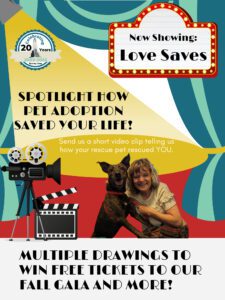 There are so many myths out there about how adopting shelter pets means taking on someone else’s problems. The best way to kill this untruth is to highlight happy-ever-after adoption stories. For example, the Animal Harbor shelter invites adopters to share stories about how rescued pets changed their lives. The best stories will be part of the shelter’s end-of-the-year “Love Saves” Pet Adoption Awareness Campaign.
There are so many myths out there about how adopting shelter pets means taking on someone else’s problems. The best way to kill this untruth is to highlight happy-ever-after adoption stories. For example, the Animal Harbor shelter invites adopters to share stories about how rescued pets changed their lives. The best stories will be part of the shelter’s end-of-the-year “Love Saves” Pet Adoption Awareness Campaign.
Developing Rescue Partnerships
A robust rescue program for both cats and dogs is an important key to keep animals moving out of the shelter. Build good relationships with trusted partners to have assortment of rescue types so that you know who to reach out when in need. Best Friends Animal Society offers a wonderful resource guide on how shelters can work with rescues to save lives. The guide includes tips on locating and assessing rescue groups, contacting rescues, and managing transports.
Donations of Cars, Boats, Trucks and More Can Benefit Homeless Animals
Animal welfare advocates can donate unwanted cars, boats, trucks, trailers, or other vehicles, whether still operational or not, to benefit the Animal Rescue Corps. Free pickup is available across most of the US, and donations may be tax deductible. The Animal Rescue Corps is a national nonprofit animal protection organization that serves several roles. Firstly, it conducts large-scale emergency rescues of animals who fall victim to abuse and disaster. Secondly, the organization offers interventions to move high-risk and at-need animals from low-adoption shelters into high-adoption regions and offers other critical assistance to in-need shelters and communities. And finally, the nonprofit raises public awareness of animal suffering and offers training for animal shelters, professionals, civilians, and volunteers.
Educate the Public About What to Expect During the Adoption Process
Use social media to let the public know what to expect during the adoption process. Just before the holiday season in December the Animal Harbor shelter, TN used a FB post to remind the community what pet adoption looks like at the shelter. This included explaining the protocols that are in place to ensure the best match possible for shelter pets and their new families. The post also reminded potential adopters that shelter pets are current on vaccinations, spayed or neutered, microchipped, and guaranteed healthy when they leave the shelter. Knowing what to expect beforehand can help make for a smoother adoption process.
Educational Opportunities for Staff
Provide opportunities for shelter staff to attend animal welfare conferences. This is a great way to network, learn about best practices at other shelters, and brainstorm with other animal rescue workers. Some shelters run fundraisers to help raise money to cover the cost of attending these conferences.
Justice Clearinghouse has more than 150,000 justice and public safety professionals within its community. The organization offers year-round virtual conferences and webinars. Many of the webinars are free and include topics geared to help animal control and animal welfare professionals. Shelters can review a list of upcoming webinars online and register in advance.
Encourage Microchipping for Found Pets
According to a study conducted by the American Veterinary Medical Association, dogs that are microchipped are 2.5 times more likely to find their way home and cats who are microchipped are 20 times more likely to find their way home. When reuniting pets with owners the Michelson Found Animals Foundation offers the following tips for shelters seeking to encourage microchipping of pets.
- Include the microchip cost on the first-day impound fee. This way an additional fee isn’t an option or barrier for owners.
- Consider offering free chipping for all reclaims. Since these animals are generally your most at-risk population (once an animal wanders away, they are at a higher risk of doing it again), offering free microchipping ensures that they can be returned to their owner quickly.
- Encourage your local government to pass a mandatory microchipping law for pets. This is an effective tool to return pets to their homes and reduce euthanasia.
- Return in the field – As a component of microchipping on reclaim, many progressive groups will return an animal while in the field if the pet is chipped, saving the pet from ever entering the shelter. Imagine how much a shelter can save when animals are returned directly to their homes by their ACOs. When they don’t enter the shelter, you can reduce the cost of care because you are not providing medical care, vaccines, food, and housing
- Implant in the field – One creative city organization, San Antonio Animal Care, has trained its officers to implant chips in the field.
- Placing microchip scanners around the community can help residents who find pets reunite them with their owners without ever having to involve the shelter. For example, the Baltimore County Department of Health and Services, MD set up five pet scanning stations around the county. Each station includes scanning instructions and how to retrieve pet owner information. The El Paso Animal Services Department, TX in partnership with 24 Pet and Best Friends Animal Society set up a solar-powered microchip scanner in a park where many stray pets were found. At the station, a mobile website accessed using a QR code walks people through the microchip scanning and report filing process.
Explain the 3-3-3 Rule to adopters
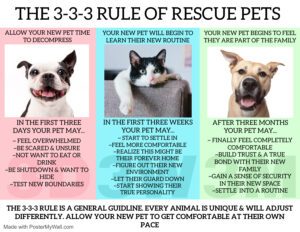 To prevent failed adoptions educate adopters about the 3-3-3 Rule so they know what to expect when they welcome a new dog into their home. Every dog is unique and will adjust differently to new life situations but in general, adopters can expect:
To prevent failed adoptions educate adopters about the 3-3-3 Rule so they know what to expect when they welcome a new dog into their home. Every dog is unique and will adjust differently to new life situations but in general, adopters can expect:
- For the first three days a rescue dog will need time to decompress
- In the first three weeks the new arrival will begin to learn his or her new routine
- After three months in a new home an adopted pet will start to feel comfortable
It’s important that adopters understand this is a general rule. Every dog needs to be allowed to get comfortable at his or her own pace.
Foster Care
Foster care is especially helpful with little ones who may need to be bottle fed or for animals with health issues. Fostering is also very helpful in preventing a litter of babies from ever entering the actual building. They still get vaccinated, dewormed, and are promoted for adoption while in their foster homes.
Get Creative When Promoting Spaying and Neutering
Posting clever attention-grabbing graphics with a link to local low-cost spay/neuter clinics can be an effective way to help fight pet overpopulation. For example many shelters and rescues take advantage of Mother’s Day and Father’s Day by posting “Don’t Be a Mother” and “Don’t Be a Father” graphics on social media.
Hard Working, Compassionate Shelter Director
Number one most important point is to have a Shelter Director agree that there is to be no more killing of healthy/treatable adoptable dogs and cats.
How to Keep Shelter Dogs Cool When Temperatures Rise
Because dogs pant instead of sweating, veterinary experts say that they are much more sensitive to heat than humans. Keeping dogs’ cool as temperatures start to rise causes an additional challenge for overcrowded Southern shelters. Following are some suggestions for how to keep dogs comfortable during the summer months. Since struggling shelters aren’t likely to have extra funds to purchase cooling equipment, educating the community about the need to keep dogs safe and comfortable while at the shelter is critical. Social media is a great way to raise awareness, seek donations, and run fundraisers.
• Dog cooling tips on a video presented by the Ridgeside K9 training facility, VA include attaching a hose with the spray head set to mister to a 6-food fan. The mister creates cold wet air helping to keep the outdoor break yard cool. The yard is also covered in artificial turf which helps to cool the dogs’ feet. Additionally, the space has sunshade sails and a tent keeping direct sunlight off of the dogs.
• Kiddie pools and plastic sandboxes make wonderful wading pools for dogs. Wooden sandboxes filled with wet sand and placed in a shady section of an outdoor run can also help keep dogs cool. These will especially be appreciated by dogs who enjoy digging.
• Add ice cubes to water bowls throughout the day to help keep the water cool.
• Distribute puppy popsicles throughout the day as a healthy cool-off treat. For example, hotdog pupsicles were a big hit with the dogs during a heatwave at the Habersham County Animal Shelter, GA. Petfinder shares a simple recipe from the Humane Society of Southern Arizona for frozen broth treats that shelter dogs will enjoy.
• Cooling bandanas, vests, collars and mats can all help keep dogs comfortable when temperatures rise. Placing a cool wet towel on a dog’s bed will also help him/her to cool down.
• Keep spray bottles with cold water on hand and use them throughout the day to cool dogs down by spraying cool water on their paws and chest.
Medical and Behavior Prevention and Rehab
 Age-appropriate vaccinations on intake and up-to-date cleaning processes. Many behavior issues can be prevented with strong enrichment programs that use all of their senses. For example:
Age-appropriate vaccinations on intake and up-to-date cleaning processes. Many behavior issues can be prevented with strong enrichment programs that use all of their senses. For example:
- Group walks
- Play groups
- Food enrichment, even something as easy as work for food puzzles
- Pick an appropriate scent to use in their kennels and then switch it up
- Soothing music
High Volume/Low-Cost Sterilization
This win-win is so obvious, not sure what else needs to be said.
Petfinder is a Great Resource for Finding Rescue Partners
Petfinder lists hundreds of shelters and rescues and is a great resource for shelters searching for potential rescue partners. To establish a list of rescues plan on searching Petfinder every few weeks. Begin the search in your state and gradually expand out to other states. You can also use this database to search for breed rescues by entering a specific breed and location in the search form and then make note of dogs available for adoption through breed rescues.
Petco Love Helping Reunite Missing Pets With Their Families
According to the American Humane Society, an estimated 10 million pets go missing each year in the US. Without a central location to report them lost and found, many of these pets may never be reunited with their families. Petco Love Lost maintains a national database of more than 170,000 dogs and cats, then creates and shares digital lost pet alerts on Nextdoor, Facebook, and via email to help reunite pets with their families. Petco Love Lost uses facial recognition technology to reunite lost dogs and cats with their rightful owners. It only takes a few minutes to register a pet and upload a recent photo onto the site. Whether it’s a new adopter proactively creating a pet profile, an individual who has recently lost a pet, or a shelter or good Samaritan looking to reunite a found pet with his/her owner, Petco Love Lost is a wonderful resource. Polk County Bully Project, FL shared on social media how a stray dog was reunited with his family thanks to the organization posting the dog’s details on the Petco Love Lost page.
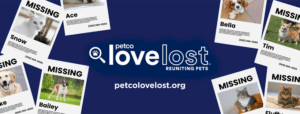
Pet Retention
When an owner surrender calls the shelter, the first question should be, “What can we do to help you keep your pet at home?” Helping the community member who has a life problem keep their pet is a successful way to keep pets in their homes. Have a list of resources available when talking with the family and discuss the best options to help them keep their pet at home. The Tazewell County Animal Shelter, VA accepts owner surrenders on a managed intake basis. The director speaks with would-be surrenders and tries to come up with solutions so that the pet can stay in his/her home. Managed intake is also practiced at the Marion County Animal Shelter, SC. Part of that practice includes asking good Samaritans who turn in pets if they can foster the animals until spaces opens up at the shelter. The shelter provides food and vet care for these strays.
In 2025 the Maury County Animal Services shelter, TN was asked to participate in a grant of $50,000 from the Pedigree Foundation awarded to Friends of Williamson County Animal Center in Franklin, TN. The grant was awarded to launch canine behavior training designed to divert the surrender of family dogs in Maury, Williamson, and Cheatham counties. The grant will allow each county to offer one-on-one in-person training to work with the specific behavior(s) prompting pet owners to surrender their dogs to shelters. Hopefully, the behaviors will be corrected and the dogs will remain with their families.
Practical Suggestions to Help Implement the No-Kill Philosophy
We have a WALDO volunteer who is an experienced shelter worker who took a high kill shelter in a poor area to a no-kill shelter in a relatively short period. She is available to consult with any shelter/rescue who would like her help. Contact info@whowillletthedogsout.org for more information.
Proactive Redemption
Proactive redemption starts with animal control out in the community before a lost pet is brought to the shelter. Rather than waiting for a family to come to the shelter to find their pets the proactive redemption approach means that animal control will try to figure out where a pet belongs and return him/her back home. Animal control officers can use the return to owner time as a way to discuss any help the family may need. And it is a perfect time to offer low or no cost spay/neuter and microchipping.
Promote the Many Ways To Help Animals
There are many people who cannot adopt a pet but would love to help shelters and rescues in other ways. Shelters and rescues can provide a list of the many ways people can help animals and post it on social media. This is also a great way to recruit new volunteers.
Provide Resources to Help Shelter Staff Deal with Compassion Fatigue
Animal welfare experts say that compassion fatigue among staff working in animal shelters across the U.S. is common and in the current animal welfare crisis it’s getting worse. Staff shortages, an increase in owner surrenders, and a decrease in the number of people adopting pets all contribute to the high levels of stress among staff. Symptoms of compassion fatigue include depression, sadness, anger, and a sense of hopelessness. This stress can negatively impact job performance and morale and lead to high staff turnover. Shelters can use the following resources to help support staff experiencing compassion fatigue:
• The Bissell Pet Foundation offers quarterly Compassion Fatigue and Burnout training sessions for public and private animal shelters.
• The Humane Pro division of the Humane Society of the United States offers a wide variety of tools and resources to help support shelter staff who are experiencing burnout or compassion fatigue.
• Maddie’s Fund Maddie’s University offers a wide selection of free online courses around the theme of compassion fatigue. For example, a course titled “Compassionate Lifesaving: Taking Care of You and Your Team to Save More Animals.” The course offers proactive tools to help shelter staff face the challenges and restore the joy in their lifesaving work.
Public Relations/Community Involvement
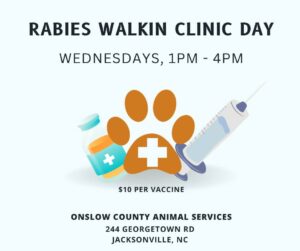 It really is all about the PR and more PR. Your community needs to not only know your needs (such as supplies, etc.) but share with them your successes as well. Use social media, websites, pet store promotions to their fullest. Rabies clinics and microchip clinics are two easy ways to let your community know you are working with them, not against them. Absolutely no people/community/owner bashing!
It really is all about the PR and more PR. Your community needs to not only know your needs (such as supplies, etc.) but share with them your successes as well. Use social media, websites, pet store promotions to their fullest. Rabies clinics and microchip clinics are two easy ways to let your community know you are working with them, not against them. Absolutely no people/community/owner bashing!
Shelter Planners of America Designs Innovative Animal Shelters
Shelter Planners of America has more than 30 years of animal shelter planning experience and has worked with more than 750 animal shelter groups. The founder of the company trained as an architect and was in charge of all animal shelter design consulting nationwide for the HSUS for 11 years. He also operated four different animal shelters for a total of 11 years as Executive Director or President. When consulting with animal welfare organizations the Shelter Planners of America company develops a Needs Assessment Study unique to a particular shelter’s community and group. The second step is to develop a layout of a shelter’s plan. The plan reflects all of the shelter’s needs and wishes while ensuring that the new or renovated and expanded building is the best it can be.
Shelter Planners of America partners with Animal Shelter Fundraising, which helps organizations to identify and raise the money necessary to get a new shelter built or complete a renovation to existing buildings.
Study Finds That Pairing Shelter Dogs Has Positive Results
The results of a new study conducted at Virginia Tech revealed that dogs housed with a well-matched companion were less stressed and adopted faster than dogs housed alone. The study was funded by the Waltham Foundation and followed 61 dogs over seven days at the Humane Society of Western Montana. The results of the study were published in the open-access research journal PLOS ONE.
Take a Holistic Approach to Getting Lost Dogs Home
Many people have no idea what to do if they lose their pets. Following are some ways shelters can help to reunite pets with their families:
• Post information on the shelter’s website about what to do if you lose or find a pet.
• Make sure it’s easy for people to navigate the reclaim process at the shelter.
• Instead of judging people whose dogs keep getting loose, help them to look for solutions. This may include offering guidance on getting pets fixed and/or microchipped.
• Lower-income people are less likely to be reunited with their pets because they cannot afford the reclaim fee. In these situations, shelters can consider returning pets to their homes while waiving the fee or billing the owner and accepting payment at a later date. For example, The Kansas City Pet Project, MO launched a Reclaim Fee Forgiveness Program to help get lost pets back home. Pet owners who reclaim their pets at the shelter within the first three days don’t have to pay a reclaim fee and will not be issued with violation tickets. This shelter also offers detailed information on its website on what to do if you lose or find a pet.
• Maddie’s Fund Return to Home Challenge offers a long list of practices shelters can implement to help reunite pets with their families. The nonprofit HeARTs Speak is another great resource for tips on how to get lost pets reunited with their families. The organization’s “Communications Kit: Lost Pet Reunification” web page includes free customizable templates, best practices, sample web pages, and technology solutions that can be accessed by animal shelters.
Teach Shelter Staff How to Monitor Playgroups
The mission of the Shelter Playgroup Alliance (SPA) is to provide animal welfare organizations with education, tailorable guidelines, and support materials for developing and implementing comprehensive enrichment programs such as playgroups at animal shelters. The WWLDO team that visits struggling shelters throughout the year reports that playgroups make a life-saving difference at the shelters they visit. Shelters can visit the SPA website for more information and details on upcoming training sessions.
Team Hikes
Animal rescue work is stressful. Shelter staff members need to support and encourage one another as they work to save lives. Taking time out for staff hikes with shelter dogs is a great team-building exercise. Group hikes are also a great way to celebrate staff anniversaries and birthdays while giving the dogs a break from the shelter.
Technology Services Designed for the Animal Welfare Community
The following companies are among the many listed in a Maddie’s Fund Forum on software solutions for animal shelters.
Animals First
The AnimalsFirst animal shelter and rescue management software is customizable to serve rescues and shelters of any size. Services include the management of animals, adopters and fosters, medical records, and field services. Software pricing starts at $24 per month.
RescueGroups.org
RescueGroups.org is a non-profit organization that provides free and low-cost technology services to the animal welfare community. Services include a pet adoption portal, data management services, and email marketing.
ShelterLuv
ShelterLuv is a software company that helps shelters and rescues to manage all the steps involved in rehoming animals. The company’s software is not a one-size-fits-all, but instead is customized to suit individual shelters and organizations. Shelterluv charges $2 per adoption for shelters using the company’s software. New clients are invited to sign up for a 14-day free trial.
Shelter Pet Data Alliance
The Shelter Pet Data Alliance (SPDA) was created by Best Friends Animal Society to give shelters and rescues a free automated platform to interact with their current data. The platform allows users to:
- Easily navigate through intakes and outcomes.
- Compare data side-by-side with 7,400 shelters and rescues.
- Review local and national trends.
- Use analyzed data to help make informed decisions.
In addition, shelters and organizations that join Best Friends as Network Partners will benefit from the following exclusive SPDA features:
- Hands-on support from the Best Friends team to create plans for breaking down a shelter’s biggest lifesaving barriers.
- Access to an experienced data scientist to help analyze data and reports.
- Help create messaging plans to rally stakeholders, the local community, and government officials to support the shelter.
Shelters can learn more about the platform and sign up online. Shelters can also apply online to become a network partner.
Take Advantage of Adobe and Canva Free Design Tools
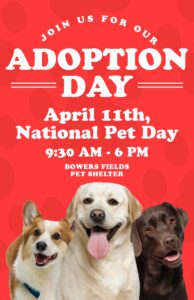
Colorful and creative posters and videos are a great way to promote shelter events, but coming up with designs can be challenging.
Adobe Express offers more than one hundred free shelter-related templates to help staff or creative volunteers customize designs sure to grab attention. Shelters can reach a wider audience by sharing colorful posters via social media or through an email sent directly from Adobe Express. Go to the Adobe Express Editable free animal shelter templates page for more information and to get started on promoting your next big event.
Canva is another free, user-friendly design tool for nonprofits. A database of 20,000 animal shelter templates offers a wonderful selection of graphic and video templates that can be used to highlight pets for adoption, promote fundraisers and upcoming events, or educate followers about responsible pet ownership. The South Georgia Equine Rescue used Canva Pro (free for nonprofits) to create a sweet video about Karot a foster dog who found a forever home. Go to the Get Started page for more information on using Canva.
Utilize Translation Services to Connect with Multicultural Communities
Shelters with multicultural communities have the additional challenge of providing information and services for people who may not speak English as a first language. Additionally, many immigrant communities don’t have animal shelters in their home countries and depending on where they live, they may not understand the services offered by local shelters in their new communities. The shelter needs to find ambassadors in these communities to work with the shelter to help animals in need and offer assistance to pet owners.
The Maddie’s Fund Open Arms Challenge identified several ways animal shelters serve their non-English speaking residents. Here are just a few examples:
• To extend its reach to the Spanish-speaking population in its community the Austin Humane Society, TX identified adoption team members who spoke Spanish. The shelter works to ensure there’s at least one Spanish-speaking counselor during every shift.
• The Broward County Animal Shelter, FL has a large Haitian population. To serve this population the shelter created an in-house team to plan outreach activities and create versions of shelter brochures in Creole.
• The Animal Rescue League of Berks County, PA works with students at Penn State University to translate shelter materials into Spanish through the college’s Spanish classes. The students help the shelter incorporate bilingual signage around the shelter and assist create bilingual content for the shelter’s website.
• In addition to using Spanish students to help translate shelter copy, Greenhill Humane Society, OR seeks multilingual candidates in job postings.
• The Humane Society of Sonoma, CA uses Google Translator to translate shelter copy and then asks a professional translator to review the copy at a reduced fee. Implementing Google Translate on your shelter’s website means that community members can select their language preference to get the information they are seeking. While translations aren’t always perfect, this is a quick, easy, and free way to support a variety of community members speaking different languages.
• The Laredo Animal Protective Society, TX implemented a phone service with an option to retrieve information in English or Spanish. The society also shares social media posts in English and Spanish and has a big following on both. For example, a Pet Pantry post in English received 2.2K views, while the same post in Spanish received 1.7k views.
Working Rescue Dogs
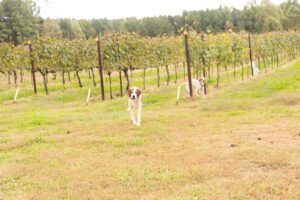 Some shelter dogs have the perfect temperament to make working dogs. For example, the Good Luck Cellars, VA grape vine patrol squad is made up of 12 rescue hound dogs. The dogs have nice dog houses, unlimited food/water, and the freedom to run and play. In exchange, they keep the deer, possums, turkeys, and raccoons from eating the vines and grapes. It’s a great life, really, and during a recent visit, WWLDO team members noted that the hounds were happily lounging in the sun or patrolling the vines. All the dogs are spayed/neutered, vaccinated regularly, and kept on heartworm and flea/tick preventatives.
Some shelter dogs have the perfect temperament to make working dogs. For example, the Good Luck Cellars, VA grape vine patrol squad is made up of 12 rescue hound dogs. The dogs have nice dog houses, unlimited food/water, and the freedom to run and play. In exchange, they keep the deer, possums, turkeys, and raccoons from eating the vines and grapes. It’s a great life, really, and during a recent visit, WWLDO team members noted that the hounds were happily lounging in the sun or patrolling the vines. All the dogs are spayed/neutered, vaccinated regularly, and kept on heartworm and flea/tick preventatives.
Click Links for More Resources
• Resource Guide
• Advocacy
• Community Outreach & Education
• Fostering
• Fundraising
• General Resources & Programs
• Grants
• Holidays – Shelter & Animal-Related
• Kids 4 Paws
• Marketing Your Dogs
• Shelter Programs & Enrichment Ideas
• Volunteer Programs & Practices
• Other Useful Shelter/Rescue Information